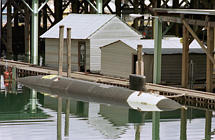NUAIR Alliance | Home
The Northeast UAS Airspace Integration Research Alliance (NUAIR) is a regional alliance of private industry, academic institutions and military assets and operations, working together to establish a Federal Aviation Administration-designated test site for unmanned aircraft systems (UAS) in the Northeast, based in New York and Massachusetts. This site will conduct testing and research in order to begin to safely integrate unmanned vehicles and systems into the National Airspace System.
Fact Sheet – FAA UAS Test Site Program
New York’s Griffiss International Airport. Griffiss
International plans to work on developing test and evaluation as well as verification and validation processes under FAA safety oversight. The applicant also plans to focus its research on sense and avoid capabilities for UAS and its sites will aid in researching the complexities of integrating UAS into the congested, northeast airspace.
Griffiss/ NUAIR Officials Say FAA Is Doing OK; UAS Test Site Making Significant
Progress Toward First Flight | Northeast Drone News
Chad Lawrence, the highly energetic and affable Deputy Commissioner of Griffiss Airport in Rome, NY attended the two day event, at which approximately 40 to 50 key individuals representing all six test sites met with FAA officials to discuss a wide range of practical considerations related to test-site ramp up. Lawrence, who could not be a more enthusiastic supporter of the UAS industry, described the meetings as extremely productive, with a highly collaborative spirit among the sites’ representatives. While details of the meetings were not made public, some of the topics reportedly covered included the process for obtaining Certificates of Authorization (COAs) for test flights, ensuring privacy requirements are met, and how information gathered during test flights will be stored and shared.
Griffiss Airport in Rome selected as national drone test site : News : CNYcentral.com
NUAIR is an alliance of more than 40 private and public entities and academic institutions from across New York and Massachusetts that have partnered to promote Griffiss as an ideal location to conduct testing and research. Officials say NUAIR could generate nearly $700 million in new York and Massachusetts, and more than 4,000 jobs.
Experts explain drone plans at Griffiss
The Unmanned Aircraft Vehicles or UAV will begin testing at Griffiss around April 1. The UAV are going to be used for more of what NUAIR is calling “agricultural” purposes, not for military purposes. Flyterra has already signed on to be the first commercial flyer drones on the base. They will collect wind and weather data, monitor crop growth, and possibly aid mail delivery. It is expected that Flyterra will test their drones for about eight months. Flyterra has been testing drones in airspace around France and Canada since 2012.
DT-18 - UAV for long distances
Delair-Tech UAV will be the first to fly over New York | sUAS News
Only days after Syracuse-based NUAIR won federal designation to operate one of six national test sites for drone aircraft, Delair-Tech is proud to announce that its DT-18 will be the first UAV to fly over New York thanks to its operator and exclusive distributor: FlyTerra LLC.
Delair-Tech manufactures the DT-18 which is the sole civilian UAV to be certified by the French Aviation Authority for Beyond Line of Sight Flight on unlimited distances in France’s civil airspace.
Drones over upstate New York: A look at an FAA test site | Al Jazeera America



















